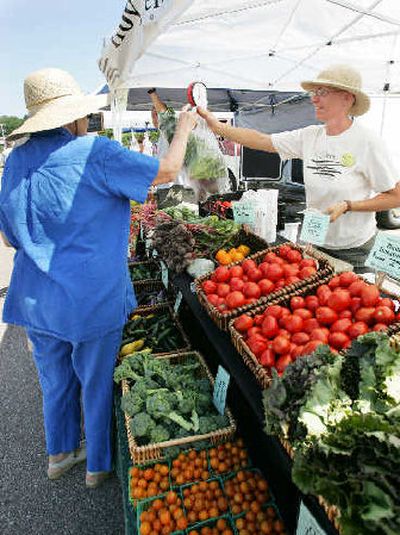Feds undermining the food pyramid

WASHINGTON — The government says half your diet should be fruits and vegetables, but it doesn’t subsidize the farmers who grow them.
Instead, half of all federal agriculture subsidies go to grain farmers, whose crops feed animals for meat, milk and eggs and become cheap ingredients in processed food.
What’s wrong with that?
“Obesity. That’s clearly the problem, if you look at the outcome in today’s society,” said Andy Fischer, executive director of the Community Food Security Coalition, a Venice, Calif., advocacy group.
Two-thirds of Americans are overweight or obese. People clearly are getting the calories they need and more, but they’re not getting enough nutrition, diet and disease experts say.
The government’s new food pyramid, unveiled in April by the Agriculture Department, aims to improve the nation’s health. It recommends that people eat fewer calories and more fruit, vegetables, lowfat milk and whole grains. It also tells people to avoid foods made with partially hydrogenated oils and sweeteners.
Federal farm programs, on the other hand, aim to maintain the financial health of American agriculture. Subsidies encourage an abundant supply of corn, wheat, rice and soybeans. Much of the corn and soybeans is fed to livestock. Some also is turned into nutrition-poor ingredients in processed food for people. For example, toaster pastries contain partially hydrogenated soybean oil that gives them a flaky texture, and they contain high-fructose corn syrup to sweeten their fruit filling. That translates to lots of calories, lots of artery-clogging fat and little or no fiber.
Such foods are becoming progressively cheaper, while the price of fruit and vegetables is rising, said Adam Drewnowski, professor of epidemiology at the University of Washington.
“If we tell a family, you really ought to be eating more salads and fresh fruit, and this is a low-income family, we’re essentially encouraging them to spend more money,” Drewnowski said.
Many groups are pushing to link farm programs, which are due for an overhaul in 2007, more closely to government nutrition goals.
“Here we are as a society, talking constantly about obesity and diets, and yet our farm policies are not structured to encourage the kind of diet that the food pyramid suggests we should adopt,” said Ralph Grossi, president of American Farmland Trust, a Washington-based group that advocates conservation on farm and ranch land.
Here is what the food pyramid says you should eat, based on a 2,000-calorie daily diet:
•3 cups of fat-free or lowfat milk or cheese.
•2 1/2 cups of vegetables.
•2 cups of fruit.
•6 ounces of grains.
•5 1/2 ounces of meat or beans.
Your plate would look quite different if it matched farm subsidies. Estimated to cost $17 billion this year, according to the Congressional Budget Office, the breakdown of farm subsidies includes:
•$7.3 billion for corn and other feed grains.
•$3.5 billion for cotton.
•$1.6 billion for soybeans.
•$1.5 billion for wheat.
•$1.5 billion for tobacco.
•$686 million for dairy.
•$626 million for rice.
•$271 million for peanuts.
The Agriculture Department doesn’t just hand out subsidies to farmers and tell people what they should eat. It operates school lunch and food stamp programs and the Special Supplemental Nutrition Program for Women, Infants and Children, or WIC. It also runs the Forest Service and oversees land conservation efforts.
With 100,000 employees and a $95 billion annual budget that includes the farm subsidies, the department has many different objectives, said Keith Collins, the agency’s chief economist.
While farm subsidies are intended to provide some income stability and financial assistance to producers, Collins said climate and market prices are much bigger factors when farmers choose what to grow.
“You’re not going to find corn in California,” he said. “You’re not going to find wine grapes in other areas like you find them there.”
He pointed out the government does help fruit and vegetable growers: They have access to federal crop insurance, and the department spends more than $400 million a year buying produce and other commodities for the school lunch program, purchasing everything from almonds and asparagus to pineapples and turkey.